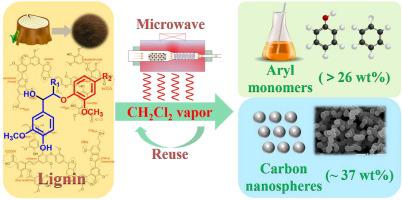Our official English website, www.x-mol.net, welcomes your
feedback! (Note: you will need to create a separate account there.)
Breaking the lignin conversion bottleneck for multiple products: Co-production of aryl monomers and carbon nanospheres using one-step catalyst-free depolymerization
Fuel ( IF 6.7 ) Pub Date : 2021-02-01 , DOI: 10.1016/j.fuel.2020.119211 Wenliang Wang , Xubiao Wang , Zhenhao Ma , Chao Duan , Shiwei Liu , Hailong Yu , Xinping Li , Liping Cai , Sheldon Q. Shi , Yonghao Ni
Fuel ( IF 6.7 ) Pub Date : 2021-02-01 , DOI: 10.1016/j.fuel.2020.119211 Wenliang Wang , Xubiao Wang , Zhenhao Ma , Chao Duan , Shiwei Liu , Hailong Yu , Xinping Li , Liping Cai , Sheldon Q. Shi , Yonghao Ni

|
Abstract Lignin is considered as a renewable and sustainable resource for producing value-added aromatic chemicals and functional carbon materials. Herein, we develop a one-step catalyst-free depolymerization strategy to convert lignin into aryl monomers and carbon nanospheres simultaneously. Importantly, microwave-assisted depolymerization (MAD) in conjunction with dichloromethane (CH2Cl2) vapors is developed. The total mass yield of guaiacols reached the highest amount of 225.1 mg/g at 600 °C, and the highest yields of phenols (49.0 mg/g) and aromatic hydrocarbons (155.1 mg/g) were obtained at 700 °C. Hydrogen radicals and hydrogen chloride (HCl) are in-situ formed from CH2Cl2, significantly decreasing the activation barrier and reforming pyrolysis vapors to promote the formation of aryl monomers. Interestingly, uniform carbon nanospheres with an average size of 140 nm were produced as co-products at 700 °C. The microwave “hot-spots”, allied with the continuous surface erosion and the decrease in surface energy of lignin-derived carbon precursors by CH2Cl2 vapor, can be considered the driving force for the ultimate formation of carbon nanospheres. The CH2Cl2/MAD system produces aryl monomers (26.8 wt% yield) and carbon nanospheres (36.6 wt% yield) at 700 °C. We provide a facile, intriguing and scalable approach to convert lignin to valuable aryl monomers and sustainable carbon materials that can be applied in the chemistry, energy and environmental fields.
中文翻译:

打破多种产品的木质素转化瓶颈:使用一步无催化剂解聚联产芳基单体和碳纳米球
摘要 木质素被认为是一种可再生和可持续的资源,可用于生产增值芳香化学品和功能性碳材料。在此,我们开发了一种一步无催化剂解聚策略,将木质素同时转化为芳基单体和碳纳米球。重要的是,微波辅助解聚 (MAD) 与二氯甲烷 (CH2Cl2) 蒸气结合使用。愈创木酚的总质量产率在 600 ℃时达到最高,为 225.1 mg/g,700 ℃时酚类(49.0 mg/g)和芳烃(155.1 mg/g)的产率最高。氢自由基和氯化氢 (HCl) 由 CH2Cl2 原位形成,显着降低活化势垒并重整热解蒸汽以促进芳基单体的形成。有趣的是,在 700 °C 下产生了平均尺寸为 140 nm 的均匀碳纳米球作为副产品。微波“热点”与 CH2Cl2 蒸汽对木质素衍生碳前驱体的连续表面侵蚀和表面能降低相结合,可以被认为是最终形成碳纳米球的驱动力。CH2Cl2/MAD 系统在 700 °C 下产生芳基单体(产率 26.8%)和碳纳米球(产率 36.6%)。我们提供了一种简便、有趣且可扩展的方法,将木质素转化为有价值的芳基单体和可持续碳材料,可应用于化学、能源和环境领域。与连续的表面侵蚀和由 CH2Cl2 蒸气引起的木质素衍生碳前体表面能的降低相结合,可以被认为是最终形成碳纳米球的驱动力。CH2Cl2/MAD 系统在 700 °C 下产生芳基单体(产率 26.8%)和碳纳米球(产率 36.6%)。我们提供了一种简便、有趣且可扩展的方法,将木质素转化为有价值的芳基单体和可持续碳材料,可应用于化学、能源和环境领域。与连续的表面侵蚀和由 CH2Cl2 蒸气引起的木质素衍生碳前体表面能的降低相结合,可以被认为是最终形成碳纳米球的驱动力。CH2Cl2/MAD 系统在 700 °C 下产生芳基单体(产率 26.8%)和碳纳米球(产率 36.6%)。我们提供了一种简便、有趣且可扩展的方法,将木质素转化为有价值的芳基单体和可持续碳材料,可应用于化学、能源和环境领域。
更新日期:2021-02-01
中文翻译:

打破多种产品的木质素转化瓶颈:使用一步无催化剂解聚联产芳基单体和碳纳米球
摘要 木质素被认为是一种可再生和可持续的资源,可用于生产增值芳香化学品和功能性碳材料。在此,我们开发了一种一步无催化剂解聚策略,将木质素同时转化为芳基单体和碳纳米球。重要的是,微波辅助解聚 (MAD) 与二氯甲烷 (CH2Cl2) 蒸气结合使用。愈创木酚的总质量产率在 600 ℃时达到最高,为 225.1 mg/g,700 ℃时酚类(49.0 mg/g)和芳烃(155.1 mg/g)的产率最高。氢自由基和氯化氢 (HCl) 由 CH2Cl2 原位形成,显着降低活化势垒并重整热解蒸汽以促进芳基单体的形成。有趣的是,在 700 °C 下产生了平均尺寸为 140 nm 的均匀碳纳米球作为副产品。微波“热点”与 CH2Cl2 蒸汽对木质素衍生碳前驱体的连续表面侵蚀和表面能降低相结合,可以被认为是最终形成碳纳米球的驱动力。CH2Cl2/MAD 系统在 700 °C 下产生芳基单体(产率 26.8%)和碳纳米球(产率 36.6%)。我们提供了一种简便、有趣且可扩展的方法,将木质素转化为有价值的芳基单体和可持续碳材料,可应用于化学、能源和环境领域。与连续的表面侵蚀和由 CH2Cl2 蒸气引起的木质素衍生碳前体表面能的降低相结合,可以被认为是最终形成碳纳米球的驱动力。CH2Cl2/MAD 系统在 700 °C 下产生芳基单体(产率 26.8%)和碳纳米球(产率 36.6%)。我们提供了一种简便、有趣且可扩展的方法,将木质素转化为有价值的芳基单体和可持续碳材料,可应用于化学、能源和环境领域。与连续的表面侵蚀和由 CH2Cl2 蒸气引起的木质素衍生碳前体表面能的降低相结合,可以被认为是最终形成碳纳米球的驱动力。CH2Cl2/MAD 系统在 700 °C 下产生芳基单体(产率 26.8%)和碳纳米球(产率 36.6%)。我们提供了一种简便、有趣且可扩展的方法,将木质素转化为有价值的芳基单体和可持续碳材料,可应用于化学、能源和环境领域。









































 京公网安备 11010802027423号
京公网安备 11010802027423号